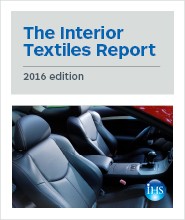
The Interior Textiles Report
The use of textiles is not just limited to apparels; the transition in the socio-economic structure of environment has enlarged the use of textiles in various applications, including automotive. Unlike apparels, automobile textiles carry a different definition and they are known as technical textiles. Technical textiles are textile materials produced for their mechanical traits and performance, rather than their aesthetic and appealing properties.
Automobile textiles, which are non-apparel textiles, are widely used in different product categories of vehicles, including interior trims, safety devices such as seatbelts and airbags, carpets, filters, battery separators, hood liners, hoses, and belt reinforcement. Their use is not only limited to enhanced automotive aesthetics; it is also widely utilised to provide comfort and safety. In addition, automobile textiles have found their use in applications such as design solutions to engineering problems in the form of composites, tire reinforcement, sound insulation, and vibration control. Both woven and non-woven fabrics are deployed in transport textiles because of certain advantages served by them.
This report looks at the factors that determine increased demand for automotive textiles, including; Weight reduction, cost, process simplicity determine materials usability; The processes used for production of door trim panels; and Suppliers’ market share for door trim panels. The report features forecasts from IHS Automotive’s Component Forecast Analytics service.
Contents
Textiles beyond apparels
- Future cars to be decked up with more textiles
- Limited resources, rising raw material prices driving demand for technical textiles
Factors predominantly determine increased demand for automotive textiles
- Increased demand for changing car interiors
- More demand for vehicles globally
- Need for lightweighting
- Demand for more safety devices
- Textiles offer solutions to engineering problems
- Textiles help suppress vehicle’s noise
Weight reduction, cost, process simplicity determine materials usability
- Urethane
- PU
- PC
- Hemp fibre–reinforced plastics
- PP compound: most preferred material for door trim panels
- Yanfeng top charts for door trim panels production using PP
Processes used for production of door trim panels
- Global market for PP resin will continue to grow
- Injection moulding process will stay in demand for door panels production
Suppliers’ market share for door trim panels
- Increased level of consolidations
- OEMs move towards modular platforms to reduce their supplier base
Global automotive interior industry continues to strengthen
- More competition going forward
Supplier Profiles
- Faurecia
- Grupo Antolin
- IAC
- Toyota Boshoku
- Yangfeng Automotive Interiors





